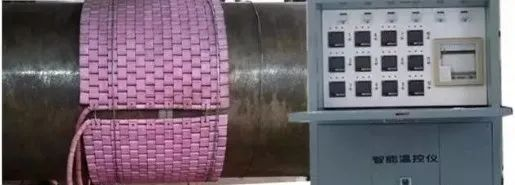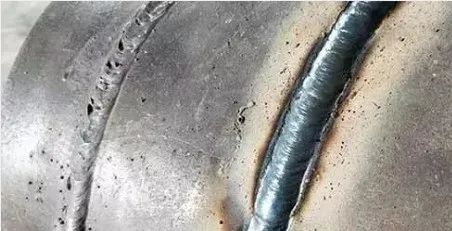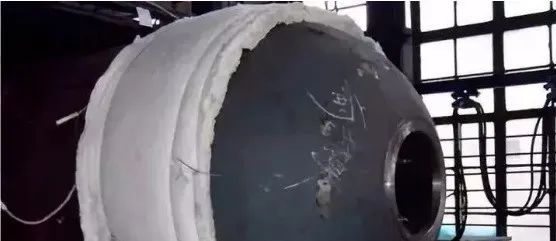Welding residual stress is caused by the uneven temperature distribution of welds caused by welding, thermal expansion and contraction of weld metal, etc., so residual stress will inevitably be generated during welding construction. The most common method to eliminate residual stress is high-temperature tempering, that is, the weld is placed in a heat treatment furnace and heated to a certain temperature and kept warm for a certain period of time. The yield limit of the material is reduced at high temperature, so that plastic flow occurs in places with high internal stress, elastic deformation gradually decreases, and plastic deformation gradually increases to reduce stress.

01 Choice of heat treatment method
The effect of post-weld heat treatment on the tensile strength and creep limit of metal is related to the temperature and holding time of heat treatment. The effect of post-weld heat treatment on the impact toughness of weld metal varies with different steel types. Post-weld heat treatment generally uses single high-temperature tempering or normalizing plus high-temperature tempering. Normalizing plus high-temperature tempering heat treatment is used for gas welding welds. This is because the grains of gas welding welds and heat-affected zones are coarse and need to be refined, so normalizing treatment is used. However, single normalizing cannot eliminate residual stress, so high-temperature tempering is required to eliminate stress. Single medium-temperature tempering is only suitable for assembly welding of large ordinary low-carbon steel containers assembled on site, and its purpose is to achieve partial elimination of residual stress and dehydrogenation. In most cases, single high-temperature tempering is used. The heating and cooling of heat treatment should not be too fast, and the inner and outer walls should be uniform.
02 Heat treatment methods used in pressure vessels
There are two types of heat treatment methods used in pressure vessels: one is heat treatment to improve mechanical properties; the other is post-weld heat treatment (PWHT). In a broad sense, post-weld heat treatment is the heat treatment of the welding area or welded components after the workpiece is welded. The specific contents include stress relief annealing, full annealing, solution, normalizing, normalizing and tempering, tempering, low-temperature stress relief, precipitation heat treatment, etc. In a narrow sense, post-weld heat treatment only refers to stress relief annealing, that is, in order to improve the performance of the welding area and eliminate harmful effects such as welding residual stress, the welding area and related parts are uniformly and fully heated below the metal phase transformation temperature point 2, and then uniformly cooled. In many cases, the post-weld heat treatment discussed is essentially post-weld stress relief heat treatment.
03Purpose of post-weld heat treatment
1. Relax welding residual stress.
2. Stabilize the shape and size of the structure and reduce distortion.
3. Improve the performance of the parent material and welded joints, including: a. Improve the plasticity of the weld metal. b. Reduce the hardness of the heat-affected zone. c. Improve fracture toughness. d. Improve fatigue strength. e. Restore or improve the yield strength reduced during cold forming.
4. Improve the ability to resist stress corrosion.
5. Further release harmful gases in the weld metal, especially hydrogen, to prevent the occurrence of delayed cracks.
04Judgment of the necessity of PWHT
Whether the pressure vessel needs post-weld heat treatment should be clearly specified in the design, and the current pressure vessel design specifications have requirements for this.
For welded pressure vessels, there is a large residual stress in the welding area, and the adverse effects of residual stress. Only under certain conditions are manifested. When the residual stress combines with the hydrogen in the weld, it will promote the hardening of the heat-affected zone, resulting in the occurrence of cold cracks and delayed cracks.
When the static stress remaining in the weld or the dynamic stress during load operation is combined with the corrosive effect of the medium, it may cause crack corrosion, which is called stress corrosion. Welding residual stress and the hardening of the base material caused by welding are important factors in the generation of stress corrosion cracks.
Xinfa welding equipment has the characteristics of high quality and low price. For details, please visit: Welding & Cutting Manufacturers - China Welding & Cutting Factory & Suppliers (xinfatools.com)
The research results show that the main effect of deformation and residual stress on metal materials is to transform the metal from uniform corrosion to local corrosion, that is, to intergranular or transgranular corrosion. Of course, metal corrosion cracking and intergranular corrosion both occur in media with certain characteristics for the metal. In the presence of residual stress, the nature of corrosion damage may change depending on the composition, concentration and temperature of the corrosive medium, as well as the differences in the composition, organization, surface state, stress state, etc. of the base material and the weld zone.
Whether welded pressure vessels need post-weld heat treatment should be determined by comprehensive consideration of the purpose, size (especially the wall thickness), performance of the materials used, and working conditions of the vessel. Post-weld heat treatment should be considered in any of the following situations:
1. Harsh operating conditions, such as thick-walled vessels with a risk of brittle fracture at low temperatures, and vessels that bear large loads and alternating loads.
2. Welded pressure vessels with a thickness exceeding a certain limit. Including boilers, petrochemical pressure vessels, etc., which have special regulations and specifications.
3. Pressure vessels with high dimensional stability.
4. Containers made of steel with a high tendency to harden.
5. Pressure vessels with a risk of stress corrosion cracking.
6. Other pressure vessels specified by special regulations, specifications, and drawings.
In steel welded pressure vessels, residual stress reaching the yield point is formed in the area near the weld. The generation of this stress is related to the transformation of the structure mixed with austenite. Many researchers point out that in order to eliminate residual stress after welding, tempering at 650 degrees can have a good effect on steel welded pressure vessels.
At the same time, it is believed that if proper heat treatment is not performed after welding, corrosion-resistant welded joints will never be obtained.
It is generally believed that stress relief heat treatment is a process in which the welded workpiece is heated to 500-650 degrees and then slowly cooled. The reduction of stress is caused by creep at high temperature, which starts from 450 degrees in carbon steel and 550 degrees in molybdenum-containing steel.
The higher the temperature, the easier it is to eliminate stress. However, once the original tempering temperature of the steel is exceeded, the strength of the steel will be reduced. Therefore, the heat treatment for stress relief must master the two elements of temperature and time, and neither is indispensable.
However, in the internal stress of the weldment, tensile stress and compressive stress are always accompanied, and stress and elastic deformation exist at the same time. When the temperature of the steel rises, the yield strength decreases, and the original elastic deformation will become plastic deformation, which is stress relaxation.
The higher the heating temperature, the more complete the internal stress is eliminated. However, when the temperature is too high, the steel surface will be severely oxidized. In addition, for the PWHT temperature of quenched and tempered steel, the principle should not exceed the original tempering temperature of the steel, which is generally about 30 degrees lower than the original tempering temperature of the steel, otherwise the material will lose the quenching and tempering effect, and the strength and fracture toughness will be reduced. This point should be given special attention to heat treatment workers.
The higher the post-weld heat treatment temperature for eliminating internal stress, the greater the softening degree of the steel. Usually, the internal stress can be eliminated by heating to the recrystallization temperature of the steel. The recrystallization temperature is closely related to the melting temperature. Generally, the recrystallization temperature K=0.4X melting temperature (K). The closer the heat treatment temperature is to the recrystallization temperature, the more effective it is in eliminating residual stress.
04 Consideration of the comprehensive effect of PWHT
Post-weld heat treatment is not absolutely beneficial. Generally speaking, post-weld heat treatment is conducive to relieving residual stress and is only carried out when there are strict requirements for stress corrosion. However, the impact toughness test of the specimens showed that post-weld heat treatment was not conducive to improving the toughness of the deposited metal and the heat-affected zone, and sometimes intergranular cracking may occur within the grain coarsening range of the heat-affected zone.
Furthermore, PWHT relies on the reduction of material strength at high temperatures to eliminate stress. Therefore, during PWHT, the structure may lose rigidity. For structures that adopt overall or partial PWHT, the support capacity of the weldment at high temperatures must be considered before heat treatment.
Therefore, when considering whether to perform post-weld heat treatment, the advantages and disadvantages of heat treatment should be comprehensively compared. From the perspective of structural performance, there is a side that improves performance and a side that reduces performance. A reasonable judgment should be made based on the basic work of comprehensively considering both aspects.
Post time: Sep-04-2024








